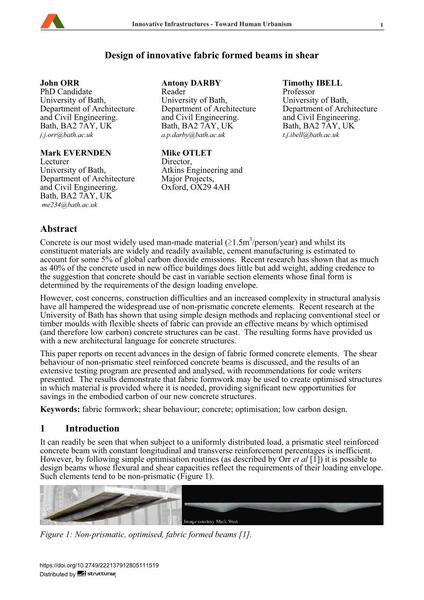Design of innovative fabric formed beams in shear

|
|
|||||||||||
Bibliographic Details
| Author(s): |
John Orr
Antony Darby Timothy Ibell Mark Evernden Mike Otlet |
||||
|---|---|---|---|---|---|
| Medium: | conference paper | ||||
| Language(s): | English | ||||
| Conference: | 18th IABSE Congress: Innovative Infrastructures – Towards Human Urbanism, Seoul, Korea, 19-21 September 2012 | ||||
| Published in: | IABSE Congress Seoul 2012 | ||||
|
|||||
| Page(s): | 1041-1048 | ||||
| Total no. of pages: | 8 | ||||
| DOI: | 10.2749/222137912805111519 | ||||
| Abstract: |
Concrete is our most widely used man-made material (≥1.5m³/person/year) and whilst its constituent materials are widely and readily available, cement manufacturing is estimated to account for some 5% of global carbon dioxide emissions. Recent research has shown that as much as 40% of the concrete used in new office buildings does little but add weight, adding credence to the suggestion that concrete should be cast in variable section elements whose final form is determined by the requirements of the design loading envelope. However, cost concerns, construction difficulties and an increased complexity in structural analysis have all hampered the widespread use of non-prismatic concrete elements. Recent research at the University of Bath has shown that using simple design methods and replacing conventional steel or timber moulds with flexible sheets of fabric can provide an effective means by which optimised (and therefore low carbon) concrete structures can be cast. The resulting forms have provided us with a new architectural language for concrete structures. This paper reports on recent advances in the design of fabric formed concrete elements. The shear behaviour of non-prismatic steel reinforced concrete beams is discussed, and the results of an extensive testing program are presented and analysed, with recommendations for code writers presented. The results demonstrate that fabric formwork may be used to create optimised structures in which material is provided where it is needed, providing significant new opportunities for savings in the embodied carbon of our new concrete structures. |
||||
| Keywords: |
concrete fabric formwork optimisation shear behaviour low carbon design
|
||||
